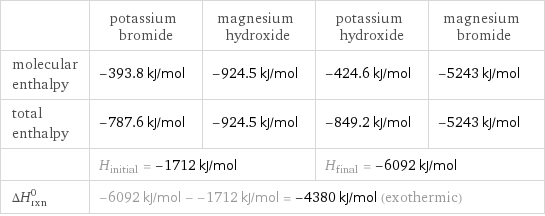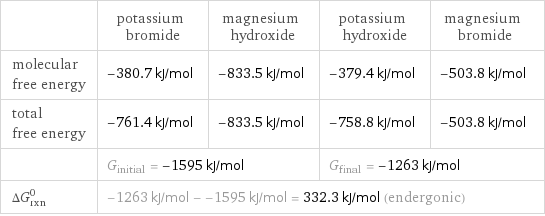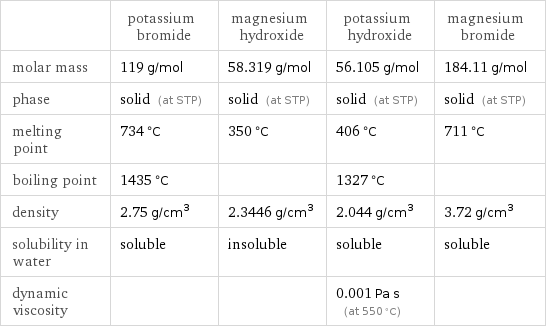Input interpretation

KBr potassium bromide + Mg(OH)_2 magnesium hydroxide ⟶ KOH potassium hydroxide + MgBr_2 magnesium bromide
Balanced equation

Balance the chemical equation algebraically: KBr + Mg(OH)_2 ⟶ KOH + MgBr_2 Add stoichiometric coefficients, c_i, to the reactants and products: c_1 KBr + c_2 Mg(OH)_2 ⟶ c_3 KOH + c_4 MgBr_2 Set the number of atoms in the reactants equal to the number of atoms in the products for Br, K, H, Mg and O: Br: | c_1 = 2 c_4 K: | c_1 = c_3 H: | 2 c_2 = c_3 Mg: | c_2 = c_4 O: | 2 c_2 = c_3 Since the coefficients are relative quantities and underdetermined, choose a coefficient to set arbitrarily. To keep the coefficients small, the arbitrary value is ordinarily one. For instance, set c_2 = 1 and solve the system of equations for the remaining coefficients: c_1 = 2 c_2 = 1 c_3 = 2 c_4 = 1 Substitute the coefficients into the chemical reaction to obtain the balanced equation: Answer: | | 2 KBr + Mg(OH)_2 ⟶ 2 KOH + MgBr_2
Structures

+ ⟶ +
Names

potassium bromide + magnesium hydroxide ⟶ potassium hydroxide + magnesium bromide
Reaction thermodynamics
Enthalpy

| potassium bromide | magnesium hydroxide | potassium hydroxide | magnesium bromide molecular enthalpy | -393.8 kJ/mol | -924.5 kJ/mol | -424.6 kJ/mol | -5243 kJ/mol total enthalpy | -787.6 kJ/mol | -924.5 kJ/mol | -849.2 kJ/mol | -5243 kJ/mol | H_initial = -1712 kJ/mol | | H_final = -6092 kJ/mol | ΔH_rxn^0 | -6092 kJ/mol - -1712 kJ/mol = -4380 kJ/mol (exothermic) | | |
Gibbs free energy

| potassium bromide | magnesium hydroxide | potassium hydroxide | magnesium bromide molecular free energy | -380.7 kJ/mol | -833.5 kJ/mol | -379.4 kJ/mol | -503.8 kJ/mol total free energy | -761.4 kJ/mol | -833.5 kJ/mol | -758.8 kJ/mol | -503.8 kJ/mol | G_initial = -1595 kJ/mol | | G_final = -1263 kJ/mol | ΔG_rxn^0 | -1263 kJ/mol - -1595 kJ/mol = 332.3 kJ/mol (endergonic) | | |
Equilibrium constant
![Construct the equilibrium constant, K, expression for: KBr + Mg(OH)_2 ⟶ KOH + MgBr_2 Plan: • Balance the chemical equation. • Determine the stoichiometric numbers. • Assemble the activity expression for each chemical species. • Use the activity expressions to build the equilibrium constant expression. Write the balanced chemical equation: 2 KBr + Mg(OH)_2 ⟶ 2 KOH + MgBr_2 Assign stoichiometric numbers, ν_i, using the stoichiometric coefficients, c_i, from the balanced chemical equation in the following manner: ν_i = -c_i for reactants and ν_i = c_i for products: chemical species | c_i | ν_i KBr | 2 | -2 Mg(OH)_2 | 1 | -1 KOH | 2 | 2 MgBr_2 | 1 | 1 Assemble the activity expressions accounting for the state of matter and ν_i: chemical species | c_i | ν_i | activity expression KBr | 2 | -2 | ([KBr])^(-2) Mg(OH)_2 | 1 | -1 | ([Mg(OH)2])^(-1) KOH | 2 | 2 | ([KOH])^2 MgBr_2 | 1 | 1 | [MgBr2] The equilibrium constant symbol in the concentration basis is: K_c Mulitply the activity expressions to arrive at the K_c expression: Answer: | | K_c = ([KBr])^(-2) ([Mg(OH)2])^(-1) ([KOH])^2 [MgBr2] = (([KOH])^2 [MgBr2])/(([KBr])^2 [Mg(OH)2])](../image_source/334b9f9fe14aec628c2939ad8e15cf38.png)
Construct the equilibrium constant, K, expression for: KBr + Mg(OH)_2 ⟶ KOH + MgBr_2 Plan: • Balance the chemical equation. • Determine the stoichiometric numbers. • Assemble the activity expression for each chemical species. • Use the activity expressions to build the equilibrium constant expression. Write the balanced chemical equation: 2 KBr + Mg(OH)_2 ⟶ 2 KOH + MgBr_2 Assign stoichiometric numbers, ν_i, using the stoichiometric coefficients, c_i, from the balanced chemical equation in the following manner: ν_i = -c_i for reactants and ν_i = c_i for products: chemical species | c_i | ν_i KBr | 2 | -2 Mg(OH)_2 | 1 | -1 KOH | 2 | 2 MgBr_2 | 1 | 1 Assemble the activity expressions accounting for the state of matter and ν_i: chemical species | c_i | ν_i | activity expression KBr | 2 | -2 | ([KBr])^(-2) Mg(OH)_2 | 1 | -1 | ([Mg(OH)2])^(-1) KOH | 2 | 2 | ([KOH])^2 MgBr_2 | 1 | 1 | [MgBr2] The equilibrium constant symbol in the concentration basis is: K_c Mulitply the activity expressions to arrive at the K_c expression: Answer: | | K_c = ([KBr])^(-2) ([Mg(OH)2])^(-1) ([KOH])^2 [MgBr2] = (([KOH])^2 [MgBr2])/(([KBr])^2 [Mg(OH)2])
Rate of reaction
![Construct the rate of reaction expression for: KBr + Mg(OH)_2 ⟶ KOH + MgBr_2 Plan: • Balance the chemical equation. • Determine the stoichiometric numbers. • Assemble the rate term for each chemical species. • Write the rate of reaction expression. Write the balanced chemical equation: 2 KBr + Mg(OH)_2 ⟶ 2 KOH + MgBr_2 Assign stoichiometric numbers, ν_i, using the stoichiometric coefficients, c_i, from the balanced chemical equation in the following manner: ν_i = -c_i for reactants and ν_i = c_i for products: chemical species | c_i | ν_i KBr | 2 | -2 Mg(OH)_2 | 1 | -1 KOH | 2 | 2 MgBr_2 | 1 | 1 The rate term for each chemical species, B_i, is 1/ν_i(Δ[B_i])/(Δt) where [B_i] is the amount concentration and t is time: chemical species | c_i | ν_i | rate term KBr | 2 | -2 | -1/2 (Δ[KBr])/(Δt) Mg(OH)_2 | 1 | -1 | -(Δ[Mg(OH)2])/(Δt) KOH | 2 | 2 | 1/2 (Δ[KOH])/(Δt) MgBr_2 | 1 | 1 | (Δ[MgBr2])/(Δt) (for infinitesimal rate of change, replace Δ with d) Set the rate terms equal to each other to arrive at the rate expression: Answer: | | rate = -1/2 (Δ[KBr])/(Δt) = -(Δ[Mg(OH)2])/(Δt) = 1/2 (Δ[KOH])/(Δt) = (Δ[MgBr2])/(Δt) (assuming constant volume and no accumulation of intermediates or side products)](../image_source/c8fdf9516672e2326e72478b74c29708.png)
Construct the rate of reaction expression for: KBr + Mg(OH)_2 ⟶ KOH + MgBr_2 Plan: • Balance the chemical equation. • Determine the stoichiometric numbers. • Assemble the rate term for each chemical species. • Write the rate of reaction expression. Write the balanced chemical equation: 2 KBr + Mg(OH)_2 ⟶ 2 KOH + MgBr_2 Assign stoichiometric numbers, ν_i, using the stoichiometric coefficients, c_i, from the balanced chemical equation in the following manner: ν_i = -c_i for reactants and ν_i = c_i for products: chemical species | c_i | ν_i KBr | 2 | -2 Mg(OH)_2 | 1 | -1 KOH | 2 | 2 MgBr_2 | 1 | 1 The rate term for each chemical species, B_i, is 1/ν_i(Δ[B_i])/(Δt) where [B_i] is the amount concentration and t is time: chemical species | c_i | ν_i | rate term KBr | 2 | -2 | -1/2 (Δ[KBr])/(Δt) Mg(OH)_2 | 1 | -1 | -(Δ[Mg(OH)2])/(Δt) KOH | 2 | 2 | 1/2 (Δ[KOH])/(Δt) MgBr_2 | 1 | 1 | (Δ[MgBr2])/(Δt) (for infinitesimal rate of change, replace Δ with d) Set the rate terms equal to each other to arrive at the rate expression: Answer: | | rate = -1/2 (Δ[KBr])/(Δt) = -(Δ[Mg(OH)2])/(Δt) = 1/2 (Δ[KOH])/(Δt) = (Δ[MgBr2])/(Δt) (assuming constant volume and no accumulation of intermediates or side products)
Chemical names and formulas

| potassium bromide | magnesium hydroxide | potassium hydroxide | magnesium bromide formula | KBr | Mg(OH)_2 | KOH | MgBr_2 Hill formula | BrK | H_2MgO_2 | HKO | Br_2Mg name | potassium bromide | magnesium hydroxide | potassium hydroxide | magnesium bromide IUPAC name | potassium bromide | magnesium dihydroxide | potassium hydroxide | magnesium dibromide
Substance properties

| potassium bromide | magnesium hydroxide | potassium hydroxide | magnesium bromide molar mass | 119 g/mol | 58.319 g/mol | 56.105 g/mol | 184.11 g/mol phase | solid (at STP) | solid (at STP) | solid (at STP) | solid (at STP) melting point | 734 °C | 350 °C | 406 °C | 711 °C boiling point | 1435 °C | | 1327 °C | density | 2.75 g/cm^3 | 2.3446 g/cm^3 | 2.044 g/cm^3 | 3.72 g/cm^3 solubility in water | soluble | insoluble | soluble | soluble dynamic viscosity | | | 0.001 Pa s (at 550 °C) |
Units
